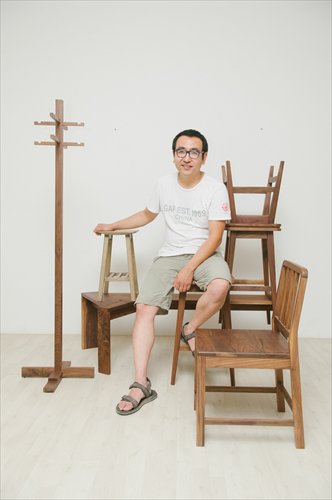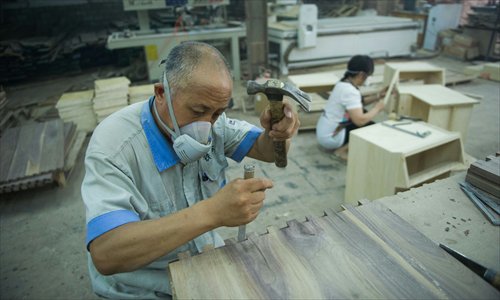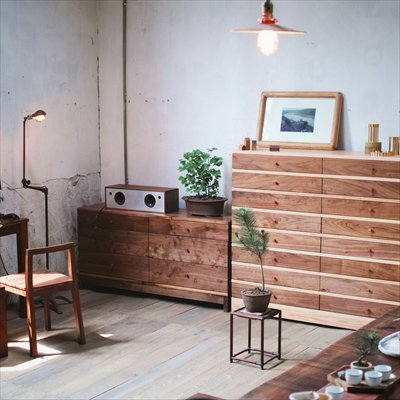Home decor boom
Independent designers are using the Internet to market their products

Zhang Yan'ge poses with his furniture. Photo: Li Hao/GT

A carpenter works at the IIINSITU Studio in Beijing. Photo: Li Hao/GT
The jarring sound of wood being sawed, sawdust floating in the air. Their faces covered by masks, carpenters at a wood workshop in north Beijing's Magezhuang, Jinzhan township in Chaoyang district cut and trim close to the capital's timber trade market. The area houses many local home furnishing factories.
Behind the workshop is the small design studio of Zhang Yan'ge. Lifestyle magazines and art books are stacked on an array of bookcases made of wave-like shelves in trapezoidal shapes, which is the signature product of the "wave system" designed and manufactured by Zhang's own brand, IIINSITU Studio.
Zhang, 37, is one of China's emerging independent furniture and home goods makers, who is riding the e-commerce model to target China's young consumers.
"I can make a name for myself thanks to the Internet, which has opened up more opportunities for independent home goods designers and retailers," said Zhang.
Capturing the market
Figures from taobao.com, the largest e-commerce platform in China, reveal that sales in the home furnishing sector have been booming over the past two years. According to an article published in business magazine CBN Weekly in June, young people who are the major consumers in the real estate market are turning to online stores to furnish their homes.
"Young consumers care less about brand and prices. They want items that represent their individual personalities and their understandings about a home," Tan Wei, head of Taobao's home sector business, told the magazine.
To serve this niche market, Taobao launched a portal called Jiyoujia in March, and IIINSITU Studio was among the first of the independent brands to sell online.
Zhang, a graduate from Esam Caen/Cherbourg in France, previously worked at a French furniture company. He became aware of the potential of the home furnishing market among young people in 2011, when he opened an online store on Taobao.
"The young generations grew up with comics and pop music which shaped their values and aesthetic tastes," said Zhang. "They don't want old-fashioned furniture based on their parents' preferences."
Zhang mainly promotes his products via social media and websites. "Independent designers have become popular on Douban and Sina Weibo since around 2010. Young people often browse social media for inspiration and price comparison before they decide on a product. There is a demand for quality, well-designed and accessible home goods, and I believe there is a huge potential to grow."
According to a Bloomberg report, a study by Deloitte released in May found that "59 percent of consumers in the US were influenced by digital interactions when shopping for home furnishings in 2014."
Items sold in Zhang's online store include ash and walnut wooden tables, chairs, cabinets and beds, priced from a few hundred yuan to thousands of yuan. In the beginning, business didn't go well.
It took ages for him to find the right factory space and he worked as a furniture photographer to pay the bills. Business improved in early 2014, when he would receive between three and 10 inquiries from online customers.
"Most of the buyers reside in Zhejiang and Jiangsu provinces and Shanghai, where people are more trusting of and rely on the e-commerce model," said Zhang.

A table designed by the Zaozuo team Photo: Courtesy of Zaozuo
Buying online
Contributing to the rise of online furniture brands is the shrinking business of domestic home furnishing manufacturers, as a result of the slump in the housing market. A number of original equipment manufacturers whose products are used in the making of foreign brands went bankrupt, after American and European companies relocated their production chain to South Asian countries where the labor costs are lower.
"We want to integrate China's furniture industry and the production capacity using an Internet model," said Guan Zishan, co-founder and the Chief Operating Officer of zaozuo.com, a startup venture specializing in selling home furnishing products online via its own website.
The company, headquartered in a 200-square-meter loft, in a courtyard in Wangjing, Chaoyang district, was founded in September 2014 and now has 42 employees with an average age of 30. "Zaozuo targets urban households with an annual income of about 200,000 yuan ($32,240). They are young people who graduated from college a couple of years ago, who are not content with the quality of Taobao products, as well as the design and prices of furniture at home furnishing malls," said Guan, a Stanford MBA graduate.
On Zaozuo's website, the company publicizes the products they are planning to launch and the estimated prices. If users are interested in any item, they can vote for their favorite colors and designs. Their choices are used as reference when finalizing the design and the production volume of the items. Users can reserve an item for as little as one yuan. "Through the 'presale model,' we can predict the sales volume of a product so as to make more accurate estimations for the furniture supply chain. The model will also help reduce the pressures of inventory and excess production," explained Guan, adding that when the product is ready to be sold, it can be discounted by up to 1,000 yuan.

Chests of drawers designed by MUMO's Li Sien Photo: Courtesy of Li Sien
Appealing designs
A leader in China's furniture market is Swedish brand IKEA, based on Scandinavian simplicity. The chain opened three new stores in China in 2014. Japanese retailer MUJI, promoting a quality lifestyle of original wood furniture and minimalist design, has also expanded rapidly.
Zhang has admitted that his designs are inspired by IKEA and MUJI, but he doesn't want his furniture to bear any resemblance to traditional furniture. "The wood and material I use are of better quality than IKEA and MUJI," said Zhang.
Most of China's independent designer brands boast the "original wood" concept, said Zhang, making the designs of online products appear similar.
But Li Sien, founder of MUMO, a furniture manufacturing factory, disagreed, saying that most independent furniture designers are respectful of intellectual property.
"For example, products of MUMO embody its own temperament decided in the manufacturing procedure and craftsmanship," said Li. "Our craftsmen use mortise and tenon joints rather than nails when connecting the different parts. The materials we choose are recyclable woods that have undergone the certification system for environmental protection and sustainable development in the US."
Influenced by his father, a local carpenter renowned for his European-style furniture designs, Li founded his brand in Ruian, Zhejiang Province, in 2010.
"In Ruian, it was difficult for us to sell our furniture until I opened a Taobao store in 2011," said Li. In 2013, Li opened his own furniture workshop with around 50 employees. "It is common for a furniture brand to find a factory to make the products. But I prefer to control the entire manufacturing process."
While China's furniture market has long been categorized according to different styles such as American, Scandinavia or European luxury, Guan said Zaozuo hoped to produce more modern design solutions rather than only the traditional ranges.
Apart from its own designers, Zaozuo also works with 30 international designers, including award-winning furniture designer Italian Luca Nichetto, and Timothy Power who worked with Louis Vuitton and MUJI to design their furniture ranges.
In January, invited by Zaozuo, Swedish industry design firm Form Us With Love, visited Beijing and Shanghai with the express intention of designing furniture for Chinese families. After realizing China's urban young people live a fast-paced lifestyle and live in comparatively small spaces, they spent six months designing the Pebble Sofa. The arc-shaped sofa is meant to resemble a hug. When the sofa was first made available for presale, 88 of them were reserved in the first three days, according to Guan.
Despite the boom in the online furniture industry, it is unlikely that they will replace physical furniture stores.
Li has opened two stores. "For a furniture brand, the design and aesthetic can be best experienced firsthand when consumers come in and touch the product," said Li.
For Zhang, who believes running a physical store in Beijing will dramatically drive up the cost of his products, he needs to find better solutions to give customers the opportunity to interact with his products before buying them.
"Maybe I will try to cooperate with a café, in which furniture can be exhibited and used by the consumers," said Zhang.